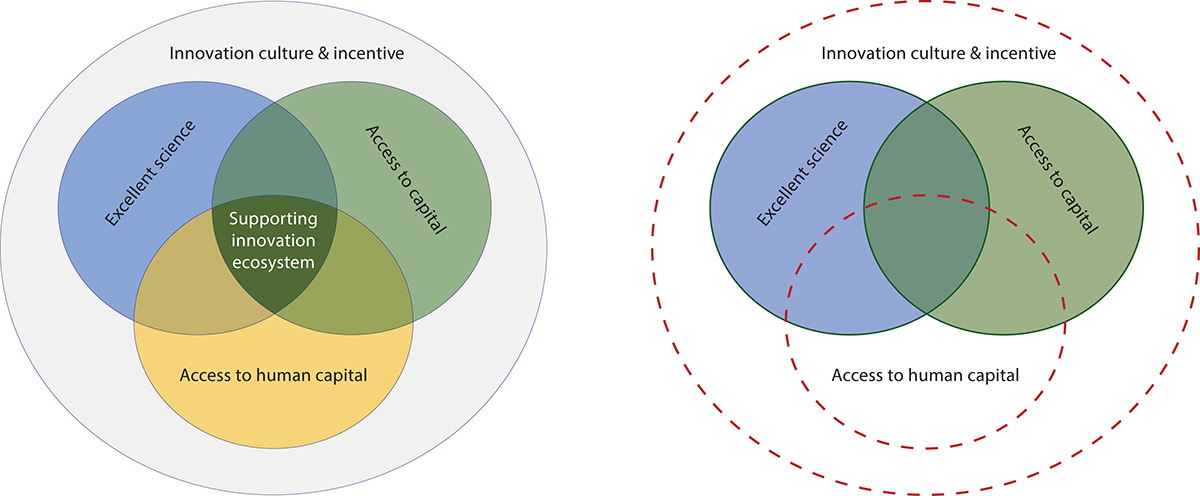Here, Cecile ten Kate discusses the process of valorisation of research projects, focusing specifically on the health innovation ecosystem
Bringing research to life and seeing it translated into real-world impacts, such as bringing important innovations to patients, is a complex process, in which many innovators fail. Evaluations of FP7 and completed health-related Horizon 2020 projects found that an estimated 80% of the results lacked real progress in terms of valorisation and advancement towards the market. This is a missed opportunity as health innovation is one of the major drivers of future growth in the knowledge-based economy and innovation in healthcare is crucial for providing benefit to citizens, as well as meeting established European priorities.
Several barriers are impeding the process of valorisation of EU-funded projects. These can relate to general barriers refer to barriers that hamper valorisation of research results in the life sciences industry or specific barriers that hamper valorisation specifically for FP7 Health and H2020 SC1 project results. For instance, once a project has ended, there is no mechanism in place to ensure that grant beneficiaries make any effort to carry out the proposed post-project exploitation or commercialisation plan and it may not be the case that all of the partners involved are otherwise incentivised or interested to keep the project going. In all cases, these barriers relate to the way the Health Innovation Ecosystem is organised.
The H2020 funded project UTILE (www.health-breakthrough.eu), is aimed at facilitating activities that translate promising health-related research results into innovations that will reach the market and have an impact on the healthcare system. This initiative presents the EU-Health Innovation Marketplace, which references all types of innovations with potential for future exploitation and/or commercialisation, primarily generated by EU Seventh Framework Programme (FP7) and Health and Horizon 2020 SC1 programmes. The UTILE Marketplace matched parties developing new innovations (partners within European projects, including academic research organisations, SMEs and large organisations) and organisations that act as facilitators for these innovations (including industry representatives, advisors, entrepreneurs, investors and other collaborative parties) and are searching for new research or business opportunities.
Valorisation of research does not take place in a vacuum, but rather through a series of steps and processes that depend upon various important partners and stakeholders and with access to various resources including not only know-how, experience and expertise (human capital), but also facilities, networks, financial resources and more: in short, valorisation requires an ecosystem in which it can take place. The fundamental rationale for designing the UTILE Marketplace as well as the other services UTILE provide finds its background in, what we investigated, is an effective Health Innovation Ecosystem.
Health Innovation Ecosystem
Within UTILE, we developed a framework and outlined conditions for the development of an effective Health Innovation Ecosystem within Europe via feedback and insights from the UTILE Market and Stakeholder Advisory Committee (MSAC) consisting of Europe’s respected and experienced industry, investment and other innovation stakeholders. The developed framework distinguished four important elements for an effective Health Innovation Ecosystem and identified the perspective of experts in the field regarding these elements.

The four elements that make up the developed framework for an effective Health innovation Ecosystem within Europe are: 1. Excellent Science, 2. Access to capital, 3. Access to human capital and 4. Culture of innovation. Within UTILE, we investigated through interviews and round tables discussion the extent to which the relative supply of these elements, or lack thereof, are perceived as barriers to innovation within Europe. As is visualised in Figure 1, the major barriers are perceived for 3. Access to human capital and 4. Innovation culture & incentive
- Excellent science – no barrier perceived: Europe generates a great deal of world-class science. There is, therefore, no relative lack or absence of world-class science in Europe which hinders or presents a barrier to the development of a strong health innovation ecosystem. Europe and the Member States should strive to maintain or improve the existing strong commitment to fostering world-class science in order to ensure that a current strength is not allowed to deteriorate and become a weakness.
- Access to capital – no/minor barrier perceived: Although there is room for improvement, access to capital in Europe for health sector innovation is not really the rate-limiting factor it is often made out to be. In particular, earlier stage capital is relatively more accessible in Europe than is generally the case in bioregions globally (exception for the leading global hotspots). There is be a minor barrier within Europe in that capital is more accessible in the more mature health clusters and financial centres than in the smaller regions and this is particularly the case with regard to development, late-stage and growth capital, hence there is a minor barrier and access to capital, especially later-stage capital, could be improved across European markets. Specific measures were proposed.
- Access to human capital – major barrier perceived: Access to human capital has been identified as a major barrier to the effective valorisation of research results and innovation within the European health innovation ecosystem. Our investigation indicated that “mediators” are important players in an effective innovation ecosystem. Mediators are those whose professional role facilitates the translation of research results or innovation from academia and research, towards the market. While many such mediators are present in Europe, there are two general problems: First, many mediators are clustered in the more developed and mature bioregions and second, the necessary networks designed to connect these mediators with innovation stakeholders are often lacking or sub-optimal. Any given region of the European health innovation ecosystem may be impacted by one or both of these challenges. A number of specific measures were proposed
- Innovation culture & incentive – major barrier perceived: The general lack of a sufficiently strong culture of innovation culture within academic and clinical settings, not only amongst researchers and clinicians but among administration and decision-makers, as well as a lack of commitment to a culture that fosters valorisation or research results have been identified as important barriers to Europe’s health innovation ecosystem. The main possible contributing factors included: 1) a lack of return on investment in terms of value for career advancement and the prioritisation of publication over research valorisation and 2) a lack of perceived value or incentivises of commitment to valorisation in terms of impact on access to research funding.
One of the final UTILE deliverables will be a series of policy recommendations addressing a number of issues but strengthening the European health innovation ecosystem will feature prominently and more attention will be paid to proposed solutions.
Please note: This is a commercial profile











